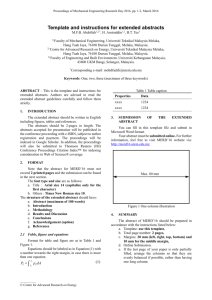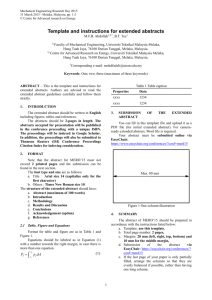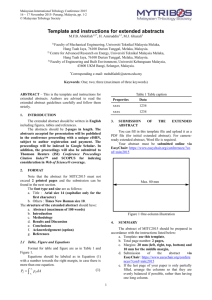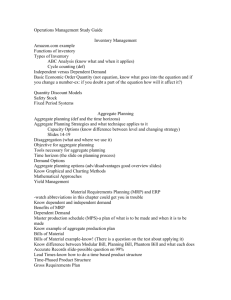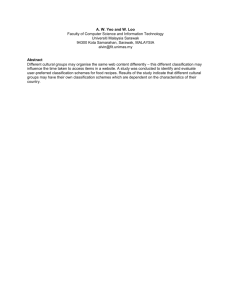8.0 Detail Syllabus and Teaching Plan
advertisement
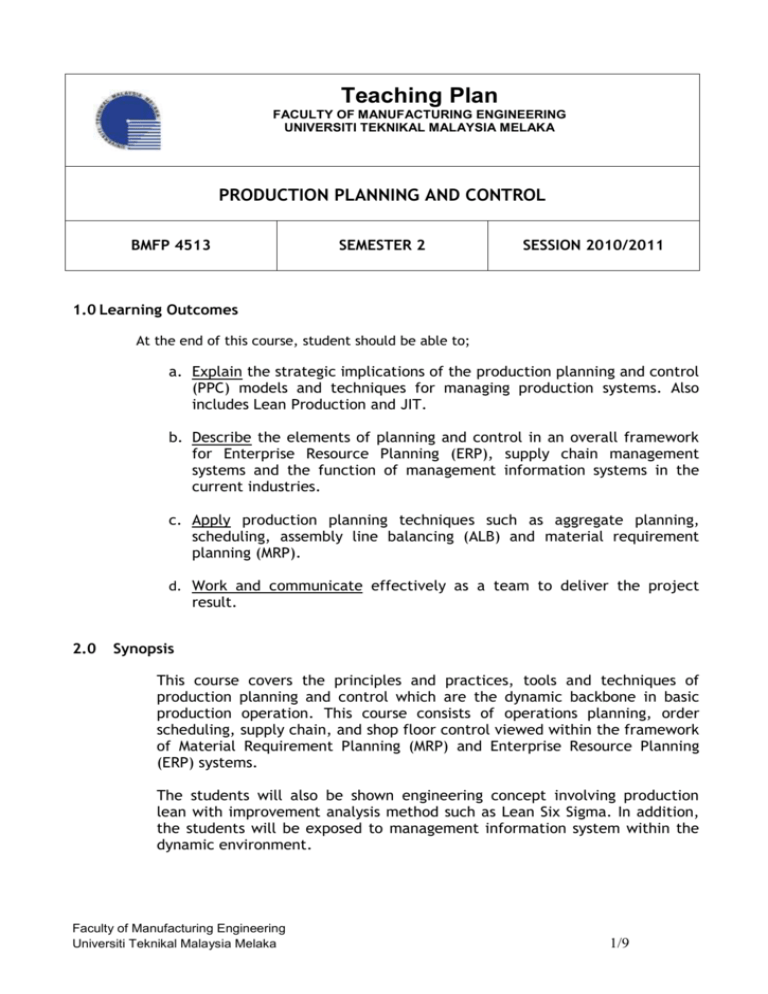
Teaching Plan FACULTY OF MANUFACTURING ENGINEERING UNIVERSITI TEKNIKAL MALAYSIA MELAKA PRODUCTION PLANNING AND CONTROL BMFP 4513 SEMESTER 2 SESSION 2010/2011 1.0 Learning Outcomes At the end of this course, student should be able to; a. Explain the strategic implications of the production planning and control (PPC) models and techniques for managing production systems. Also includes Lean Production and JIT. b. Describe the elements of planning and control in an overall framework for Enterprise Resource Planning (ERP), supply chain management systems and the function of management information systems in the current industries. c. Apply production planning techniques such as aggregate planning, scheduling, assembly line balancing (ALB) and material requirement planning (MRP). d. Work and communicate effectively as a team to deliver the project result. 2.0 Synopsis This course covers the principles and practices, tools and techniques of production planning and control which are the dynamic backbone in basic production operation. This course consists of operations planning, order scheduling, supply chain, and shop floor control viewed within the framework of Material Requirement Planning (MRP) and Enterprise Resource Planning (ERP) systems. The students will also be shown engineering concept involving production lean with improvement analysis method such as Lean Six Sigma. In addition, the students will be exposed to management information system within the dynamic environment. Faculty of Manufacturing Engineering Universiti Teknikal Malaysia Melaka 1/9 3.0 Practical Application Students are assumed to be familiar with basic statistics, operation research, and operation management. Students will be required to perform one (1) individual assignment and one (1) group assignment/ case study and one (1) group presentation that expose production planning and control techniques which most of industries apply. There will be a project that also will be based on industrial problems which will enhance their understanding in the topics of the chapter they are learning. The assignment /case study will cover necessary chapters that will enable the students to have comprehensive understanding on PPC tools and techniques. Based on one (1) group assignment, the student will discuss about the application on this subject. Students will be grouped into 3-4 students per group for the group assignment and group presentation in order to expose the students to team work. Presentation for project is necessary, so that each team may share the knowledge with others. 4.0 References 5.0 No. 1 2 3 4 5 6 7 1. Nahmias, S. (2008) Production Operations Analysis. Mc Graw Hill/ Irwin. 6th Edition 2. Vollman, T.E., Berry, W.L. Whyback, D.C. and Jacobs, F.R. (2005). Manufacturing Planning and Control for Supply Chain Management. 5 th Edition. Mc Graw Hill/Irwin 3. Stephen, N.C. (2005). Fundamentals of production Planning and Control. Prentice Hall. 4. Krawjewski J.L. and Ritzman P. L., (2002), Operations Management: Processes Value Chains. 7th Edition, Prentice Hall International Series. 5. Seng,Y.Kam (2003), Industrial Management, 3rd Edition Prentice Hall. Course Implementations Session Lecture Tutorial Case Study Project & Presentation Quiz Test Final exam TOTAL GRAND TOTAL Hrs 3 1 1 2 0.5 1.5 3 Official contact hours = 62.5 hrs Faculty of Manufacturing Engineering Universiti Teknikal Malaysia Melaka Freq 14 10 2 1 4 1 1 Official Contact SLT Hrs 42 2 10 2 2 2 2 3 2 1 1.5 3 3 4 62.5 128.5 Freq 14 10 2 1 4 1 1 Student Learning Time (SLT) 28 20 4 3 4 3 4 66 Expected student self-learning = 66 hrs 2/9 6.0 Course Evaluations NO. COURSE WORK 1 Case study – 1 Individual activity (report) 2 Case study -2 Group activity (report) 3 Project (Case Study-2) Presentation x 1 Group project basis presentation (3 ~ 4 persons/group) 4 Quiz x 4 Test on student’s knowledge and understanding about the relevant topic 5 Test x 1 (1.5 hr) Test on student’s knowledge and understanding about the relevant topic. Final Exam (3 hrs) 6 Understanding, Applications, Problem Solving and Decision Making. TOTAL 7.0 PERCENTAGE, % 7.5 7.5 10 @2.5 (10) 15 50 100 Method of Assessment COMPONENT Tests / Quizzes Project & Presentation Assignment and Case Study KNOWLEDGE X X COMPETENCY X X ATTITUDE X X X X X COMMUNICATION X 8.0 Detail Syllabus and Teaching Plan Week 1 2 Session Contents 20 -24 FEB’12 1.0 INTRODUCTION TO PRODUCTION PLANNING AND CONTROL 1.1 Production Systems 1.2 Production process objectives 1.3 Functions in production systems 27 FEB- 2 MARCH’12 2.0 COMPETITIVENESS, STRATEGY, AND PRODUCTIVITY 2.1 Competitiveness 2.2 Strategy 2.3 Productivity Faculty of Manufacturing Engineering Universiti Teknikal Malaysia Melaka Remarks Course Outline Briefing Tutorial 1 3/9 Week 3 4 Date 5-9 MARCH’12 12 – 16 MARCH’12 Contents 3.0 AGGREGATE PLANNING 3.1 Overview of aggregate planning 3.2 Demand capacity option 3.3 Aggregate units of production 3.4 Technique for aggregate planning. • Spreadsheet methods • Linear programming methods. 3.0 AGGREGATE PLANNING (con’t) • Disaggregation 3.5 Costs in aggregate planning 3.6 Solving aggregate planning problems 3.7 The linear decision rule 3.8 Modeling management behavior 4.0 5 19 – 23 MARCH’12 4.0 6 7 8 26 – 30 MARCH’12 SCHEDULING 4.1 Introduction 4.2 Job Shop Scheduling Terminology 4.3 Sequencing Rules • FCFS • SPT • EDD • CR SCHEDULING (con’t) 4.4 Sequencing Theory for a Single Machine 4.5 Sequencing Theory for Multiple Machines 4.6 Assembly Line Balancing 4.7 Advanced Topics for Operations scheduling 2-6 APR’12 5.0 MATERIAL REQUIREMENTS PLANNING 5.1 Background and fundamentals concepts 5.2 Dependent Inventory Model Requirement • Master Production Schedule • Bills of Material • Accurate Inventory Records • Lead Times for components 5.3 MRP Structure 5.4 Potential MRP challenges 9 - 13 APR’12 SEMESTER BREAK Faculty of Manufacturing Engineering Universiti Teknikal Malaysia Melaka Remarks Tutorial 2 & Quiz 1 [Presentation 1] Tutorial 3 [Presentation 2] Tutorial 4 & Case Study 1 [Presentation 3] Tutorial 5 & Quiz 2 [Presentation 4] Tutorial 6 TEST 1 [Presentation 5] 4/9 Week Session Contents 6.0 9 16 – 20 APR’12 6.1 6.2 6.3 6.4 10 11 23 – 27 APR’12 30 APR 4 MAY’12 Remarks ENTERPRISE REQUIREMENTS PLANNING (ERP) Background and fundamentals concepts Advantages and Disadvantages of ERP Systems ERP in the Service Sector Potential and Challenges 7.0 SUPPLY CHAIN 7.1 What is SCM 7.2 Information in SCM 7.3 Formulations 7.4 Distribution and Warehouse Management 7.0 7.5 7.6 7.7 [Presentation 7] SUPPLY CHAIN (con’t) Transportation methods Design and solutions Global supply chain Tutorial 9 [Presentation 8] 7 - 11 MAY’12 13 14 - 18 MAY’12 9.0 MIS 9.1 General system design and selection 9.2 General implementation approaches 9.3 SAP 9.4 BAAN IV 14 21 - 25 MAY’12 15 28 MAY – 1 JUNE’12 10.0 REVIEW (The materials – PPC) Tutorial 10 & & Quiz 4 [Presentation 9] [Presentation 10] [Presentation 11] [Presentation 12] [Presentation 13] concept 10.1 Manufacturing Process The Next Frontier [Presentation 6] Tutorial 8 & Quiz 3 8.0 LEAN 8.1 Lean production and JIT • Fundamentals and concepts • Some impacts on capacity 8.2 Pull System 8.3 Kanban 8.4 Using kanban system for process improvement 8.5 Master scheduling and lean production 8.6 Six Sigma fundamental concepts (DMAIC) 12 Tutorial 7 & PROJECT and Control: 10.0 REVIEW (The concept and materials – PPC) (cont’) 16 Faculty of Manufacturing Engineering Universiti Teknikal Malaysia Melaka FINAL EXAM 5/9 8.0 Matrix of Learning Outcomes: PROGRAM OUTCOMES No Learning Outcome 1. Explain the strategic implications of the production planning and control (PPC) models and techniques for managing production systems. Also includes Lean Production and JIT. 2 3 4. Describe the elements of planning and control in an overall framework for Enterprise Resource Planning (ERP), supply chain management systems and the function of management information systems in the current industries. Apply production planning techniques such as aggregate planning, scheduling, assembly line balancing (ALB) and material requirement planning (MRP). Work and communicate effectively as a team to deliver the project result. Faculty of Manufacturing Engineering Universiti Teknikal Malaysia Melaka P0 1 P0 2 X P0 3 P0 5 P0 6 P0 7 P0 8 P0 9 P0 10 X X X P0 4 X X X X X X X X 7/9 P0 11 Delivery Assessment Lecture Case study Group activity Assignment Tutorial Quiz, Test, Final Exam, Project Report, Case Study Report Lecture Case study Assignment Tutorial Quiz, Test, Final Exam, Project Report, Case Study Report Lecture Case study Assignment Lab activity Test, Final Exam, Project Report Lecture Case study Assignment Lab activity Case study Project Report Presentation KPI 60% Student Achieve Grade C Above CS Learning Outcomes for BMFP 4513 1 1 Explain the strategic implications of the production planning and control (PPC) models and techniques for managing production systems. Also includes Lean Production and JIT. x 2 Describe the elements of planning and control in an overall framework for Enterprise Resource Planning (ERP), supply chain management systems and the function of management information systems in the current industries. x x x 3 Apply production planning techniques such as aggregate planning, scheduling, assembly line balancing (ALB) and material requirement planning (MRP). x x 4 Work and communicate effectively as a team to deliver the project result. x x 2 3 4 CTPS 5 6 7 8 1 2 3 x x x x x x x x x x x x x x x x x x 4 x TS 5 6 7 x 1 2 3 4 5 x x x x x x x x x x BMFP 4513 LL Learning Outcomes for BMFP 4512 1 2 x x 1 Explain the strategic implications of the production planning and control (PPC) models and techniques for managing production systems. Also includes Lean Production and JIT. 2 Describe the elements of planning and control in an overall framework for Enterprise Resource Planning (ERP), supply chain management systems and the function of management information systems in the current industries. 3 Apply production planning techniques such as aggregate planning, scheduling, assembly line balancing (ALB) and material requirement planning (MRP). x 4 Work and communicate effectively as a team to deliver the project result. x ES 3 1 2 3 4 1 2 x LS 3 1 2 x x x x x x x BMFP 4513 Faculty of Manufacturing Engineering Universiti Teknikal Malaysia Melaka EM 8/9 x 3 4 LO KURSUS VERSUS TAKSONOMI PSIKOMOTOR KOGNITIF Learning Outcomes for BMFP 4513 1 2 3 1 Explain the strategic implications of the production planning and control (PPC) models and techniques for managing production systems. Also includes Lean Production and JIT. x x 2 Describe the elements of planning and control in an overall framework for Enterprise Resource Planning (ERP), supply chain management systems and the function of management information systems in the current industries. x 3 Apply production planning techniques such as aggregate planning, scheduling, assembly line balancing (ALB) and material requirement planning (MRP). x x x 4 Work and communicate effectively as a team to deliver the project result. x x x 4 5 6 1 2 x x 3 4 x x 6 7 1 2 3 x x x 4 x x x x x x x x x x x x x BMFP 4513 Faculty of Manufacturing Engineering Universiti Teknikal Malaysia Melaka 5 AFEKTIF 9/9 x 5 APPROVAL Prepared by ; Approved by ; …………………………. Name : Hasoloan Haery Post : Stamp : ……………………………….. Dean/Deputy Dean(Academic)/Head of Dept. Stamp : Date Date : __________________ : _________________ TEACHING PLAN IMPLEMENTATION STATUS (MID-SEMESTER BREAK) Comments : Check by ; ……………………………….. Dean/Deputy Dean(Academic)/Head of Dept. Stamp : Date : _______________ TEACHING PLAN IMPLEMENTATION STATUS (16th WEEK OF SEMESTER) Comments : Check by ; ……………………………….. Dean/Deputy Dean(Academic)/Head of Dept. Stamp : Faculty of Manufacturing Engineering Universiti Teknikal Malaysia Melaka Date : _______________ 10/9
